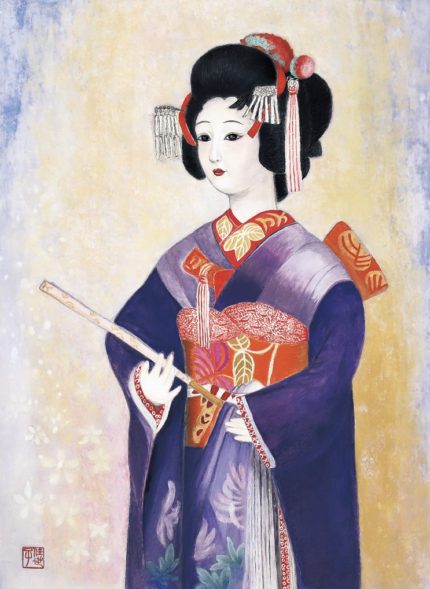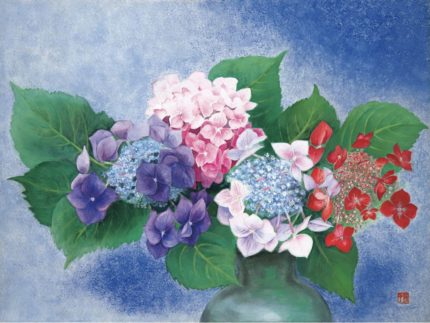- JEPAA Member
- Japanese-style paint/Western-style paint
- Kayoko Hirosue
- 日本画
- 広末佳代子
© 2024 Kayoko Hirosue.
SCROLL
Portfolio /作品一覧
- 羽子板を持つ日本人形 /Japanese doll with Hagoita
- 紫陽花/hydrangea (Hydrangea macrophylla)
- ノイシュバンシュタイン城/Neuschwanstein Castle
view more
Interview article /対談記事
「広末先生の表現力は力強くて素晴らしいです」
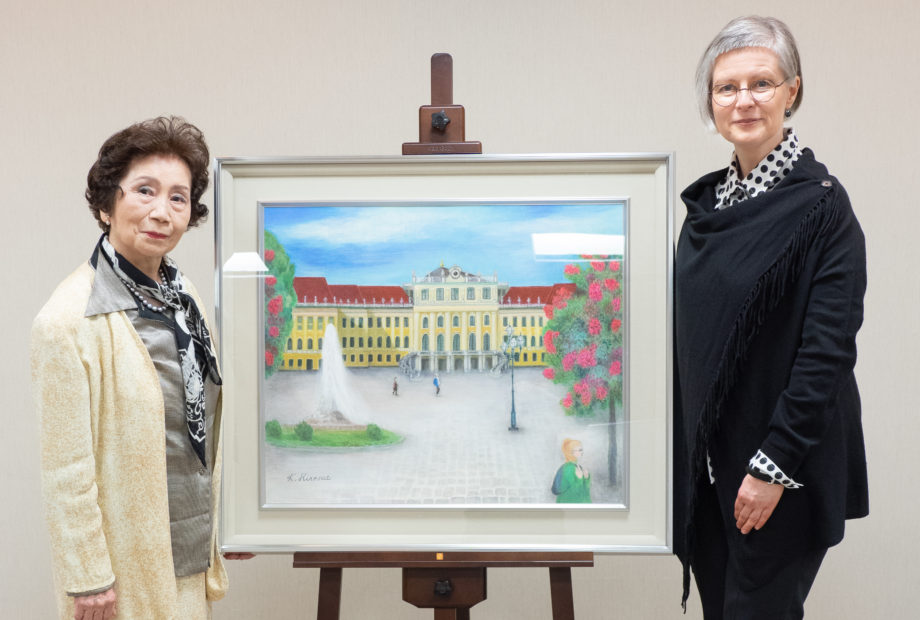
ハイケ・イェローミン(以下、ハイケ):広末先生お久しぶりです。5月にウィーンの日欧宮殿芸術祭でお会いして以来となりますが、今回出展していただいた作品ではシェーンブルン宮殿を描いていただいたのですね。ありがとうございます。
広末佳代子(以下、広末):ウィーンでは大変お世話になりました。その時に展覧会の会場となったシェーンブルン宮殿の感動を、作品としてみようと思って筆を取りましたが、思うように制作が進まないので、苦労しました。
ハイケ:こちらは、撮影した写真などを元に描いたのでしょうか?
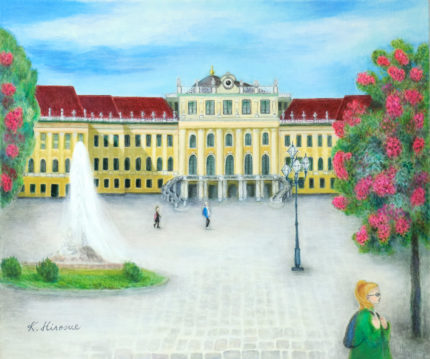
広末:スケッチを残していたんです。日本に帰国してから改めて制作に取り組んだのですが、建築物などは数えるほどしか描いたことがなかったので、とくに窓の細かな装飾などは難しかったですね。構図についても、自分なりに色々と調整しましたし、思い出のままに描いてしまった箇所もあるので、実物と比べると違う点も多いかもしれません。
ハイケ:良い作品を描く上で、見たままを描くより構図の方が大切です。それに、正確さよりも思い出を大切にしているからこそ、絵画として優れているのではないでしょうか。個人的には、シェーンブルン宮殿の堂々とした風格が表現されていて、素晴らしいと思います。色合いも輝きがあって、神々しいですよね。一方で周辺に描き込まれた人や木々に、広末先生の優しい人柄が表されているように感じました。
広末:ありがとうございます。
ハイケ:本日は、素晴らしい日本画をたくさん手掛けている広末先生に、ぜひ日本画の基本についてレクチャーいただきたいのですが、そもそも私たちが描く油絵とは、何が違うのでしょうか?
広末:まず紙が違いますね。油絵はキャンバスに描きますが、日本画は和紙を使います。そして、絵具も違いますが、とくに膠(にわか)を使って定着させていく点は、油絵にはまったく無い意識だと思います。そして、制作する人間にとって大きな違いとなるのが、乾いた時の色の具合ですね。油絵は、描いた時と乾いた時で色がほぼ変わりませんが、日本画は乾くと全然違う色になります。ですから乾いた時の仕上がりを予想したり、乾いた後に調整するなど、油絵を描いている場合、より一作にかかる時間が長くなりますね。
ハイケ:仕上がりが違うというのは、出来上がりが楽しみでもありますが、予測できない分、難しいと思います。それだけに、広末先生のように、経験と技術がしっかり備わっている方でなければ、良い作品には仕上がらないのですね。広末先生は日本画も油絵も両方描いているとのことですが、それだけ違いがあるものを両立できるというのは、同じ芸術家として尊敬に値します。
広末:そういってもらえるのは嬉しいですね。以前は立派な絵を描くことで、日本画の文化を後世に残していければと意気込んでいましたが、最近では、そんな壮大なことは考えず、自分なりに良いと思える絵を伝えていければ十分かなと思っています。
ハイケ:私には、広末先生のように表現力の優れた画家が、そのように思わなくてはならないというのが不思議に思えます。先生の作品には、表現の喜びがあります。
広末:ありがとうございます。芸術の本場ウィーンの方にそう言ってもらえるのは、思いがけない喜びです。私は主に日本画を描いていますが、実はヨーロッパの芸術が好きで、とくにルーベンスの作品に心惹かれています。中でも「ルーベンスとイサベラ・ブラント」のように幸福感が溢れているものが好きですね。
ハイケ:私は、後期バウハウスの流れを汲む芸術が好きで、中でもリオネル・ファイニンガーの現代表現主義の先駆的作品をよく鑑賞していました。先生には、ぜひその表現力の力強さを大切に、幸福感の溢れる作品をこれからも描き続けていただきたいと思います。どうもありがとうございました。
(2022年 広末佳代子×ハイケ・イェロミン対談)
“Ms. Hirosue’s power of expression is compelling and magnificent.”
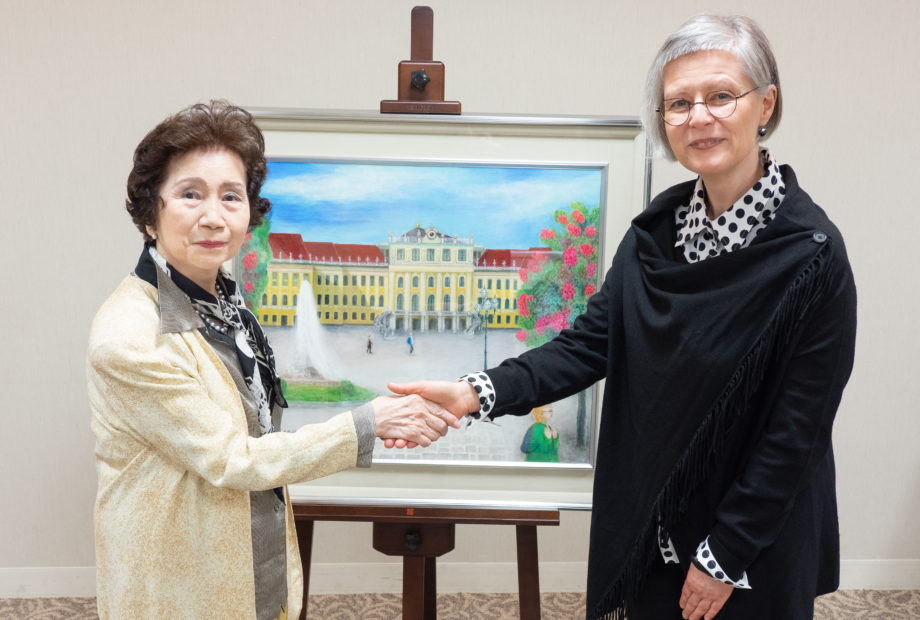
Heike Jeromin (hereinafter referred to as“ Heike”):It’s been a while since I’ve seen you, Ms.Hirosue. This is the first time I’ve seen you since we last met in May at the Japan-Europe Palace Art Festival in Vienna. But this time, the work you exhibited was a painting of Schönbrunn Palace, wasn’t it? Thank you for doing that.
Kayoko Hirosue (hereinafter referred to as “Hirosue”): Thank you very much for your help in Vienna. At the time, I was deeply moved by the fact that the exhibition was being held at Schönbrunn Palace. So that’s when I decided to pick up a brush and express my feelings in the form of a painting. But in the end, I had a hard time because the painting didn’t turn out the way I expected.
Heike: Did you paint this piece based on photos you took?
Hirosue: I first did a sketch. And once I got back to Japan, I then started working on it again.But because I only drew as many buildings as I could see, it was particularly difficult for me to paint things like the detailed embellishments on the windows. For the layout, I made various adjustments as I went along and also painted some parts based on what I remembered of them. That’s why my painting might be very different from the real thing.
Heike: To paint a good painting, getting the layout right is more important than painting what you see. Besides, wouldn’t that make your piece an excellent painting since it values your memories over accuracy? Personally, I think it’s wonderful since it illustrates the grand nature of Schönbrunn Palace. The color scheme is also radiant and has a divine quality to it. On the other hand, I also felt that your gentle character was expressed in the people and trees painted in the surroundings.
Hirosue: Thank you.
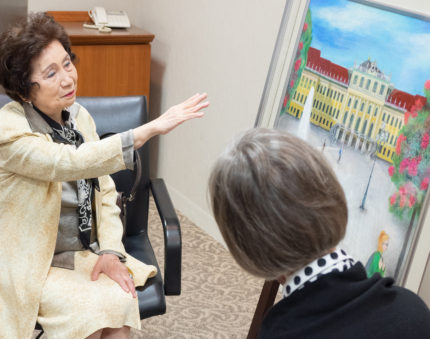

Heike: Today, I’d definitely like to attend your lecture on the basics of Japanese paintings,seeing that you’re someone who has a lot of experience with Japanese paintings. But what would you say are the innate differences between Japanese paintings and the oil paintings we paint?
Hirosue: First of all, the paper is different. Oil paintings are done on canvases, while Japanese paintings are done on Japanese paper. Also, the paints are different too. I feel like the technique of gluing things onto paper, in particular, is not somethings that’s used at all in oil paintings. The way the colors turn out once the paint dries is also something that differs greatly depending on the painter. With oil paintings, the color of the paint is more or less the same before and after drying. However, with Japanese paintings, the paint turns into a completely different color once it’s dry. That’s why it takes a long time to complete a single Japanese painting, since time needs to be spent on doing things like predicting how the painting will turn out once the paint dries, or making adjustments after the paint dries.
Heike: Having a painting turn out different from your expectations can be exciting. But I think it’d also be difficult not being able to predict what it’ll look like. For that reason, it’d also be impossible for someone to paint a good painting, unless they were equipped with the solid skills and experience of someone like you.As an artist, myself, I feel that the way you’re able to paint both Japanese paintings and oil paintings, which are very different from each other, is something that’s worthy of respect.
Hirosue: I’m happy to hear you say that. In the past, I was eager about leaving a piece of Japanese painting culture for the future generations to see by painting magnificent pieces of work. But nowadays, I no longer have those sort of thoughts. Instead, I now think that being able to convey the meaning of paintings I consider good is suffice.
Heike: It’s puzzling to me that a painter with such a great power of expression like yourself would feel the need to think that way. There’s just a joy of expression in your work.
Hirosue: Thank you. It’s an unexpected joy for me to be told that by someone from Vienna,which is the center of art. I mainly do Japanese paintings, but I actually really like European art too. I’m especially drawn in by the work of Rubens. Of his work, I particularly like the pieces that are filled with a sense of happiness, such as the one titled“ Honeysuckle Bower.”
Heike: For me, I like art that is derived from the later style of Bauhaus. In particular, I often went to see Lyonel Feininger’s work, which pioneered modern expressionism. Ms. Hirosue,I hope that you will continue to cherish your immense power of expression while creating paintings that are filled with a sense of happiness. Thank you very much for today.
(2019 Talk Session Kayoko Hirosue and Heike Yeromin )
Solo exhibition/個展
特設個展ブースin 日欧宮殿芸術祭2022
会期:2022年4月24日~26日
会場:ハル ドゥ ブラン マントゥ(フランス・パリ)
主催:一般社団法人 日欧宮殿芸術協会
運営:クリエイト・アイエムエス株式会社
Special exhibition booth at the JEPAA Festival 2022
Date: April 24-26, 2022
Venue: Halle des Blancs Manteaux (Paris, France)
Organizer: Japan-Europe Palace Art Association
Operation: Create IMS Co., Ltd.
特設個展ブースin 日欧宮殿芸術祭2021
会期:2021年6月4日~6日
会場:シャルロッテンブルク宮殿(ドイツ・ベルリン)
主催:一般社団法人 日欧宮殿芸術協会
運営:クリエイト・アイエムエス株式会社
Special exhibition booth at the JEPAA Festival 2021
Date: June 4-6, 2021
Venue: Charlottenburg Palace (Munich, Germany)
Organizer: Japan-Europe Palace Art Association
Operation: Create IMS Co., Ltd.
特設個展ブースin 日欧宮殿芸術祭2019
会期:2018年5月3日~5日
会場:シェーンブルン宮殿(オーストリア・ウィーン)
主催:一般社団法人 日欧宮殿芸術協会
運営:クリエイト・アイエムエス株式会社
Special exhibition booth at the JEPAA Festival 2019
Dates: May 3-5, 2018
Venue: Schoenbrunn Palace (Vienna, Austria)
Organizer: Japan-Europe Palace Art Association
Operation: Create IMS Co., Ltd.
Profile /経歴
広末佳代子 Kayoko Hirosue
1940年 兵庫県出身
京都市美術大学日本画科卒業
師・篁谷、上村淳之
作品出展国遍歴(JEPAA関連事業):ドイツ、マルタ、ベルギー、フランス他
Born: 1940 Hyogo, Japan
Education:Japanese painting department,Kyoto City University of Arts
Master: Kohkoku, Atsushi Uemura
Exhibition of Works(JEPAA): Germany, Malta, Belgium, Canada…

